
Original Link: https://www.anandtech.com/show/1633
IDF Spring 2005 - Day 2: Mobility Keynote
by Anand Lal Shimpi on March 2, 2005 1:21 PM EST- Posted in
- Trade Shows
After an extremely eventful Day 1, Intel kicked off Day 2 of the Intel Developer Forum with a keynote by Sean Maloney, Intel's Executive VP and General Manager of the Mobility Group.
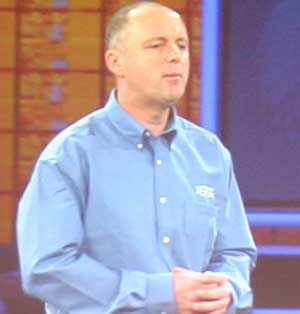
Maloney's keynote started by talking about Intel's involvement in mobile phones, PDAs and flash memory. The first demo of the day was actually quite impressive, even though it wasn't of any new technology.
Sean Maloney had two systems setup, a 3 - 4 year old Thinkpad notebook and what appeared to be a similarly old desktop computer. He was playing Meet the Fockers on both platforms, with the Thinkpad clearly dropping frames in the video, while the desktop computer was playing it smoothly. Not too surprising right? Then he lifted the case off of the desktop PC and revealed that the video was playing back on a cell phone - faster than a laptop from 3 - 4 years ago.
Phones have been getting more and more powerful, and things are only going to get better from here.
Intel also showcased some of the benefits of high speed data connections on Cell phones such as 1-button Connect. The idea behind 1-button Connect is by clicking one button on your notebook or phone, you can have your phone automatically sync everything with your PC wirelessly. It's nothing too amazing, but the importance of synchronization will increase as cellular bandwidth increases and storage space goes up on phones.
The New Centrino: 2006 Napa Platform
Maloney talked a bit about the 2006 Napa Mobile Platform, the next-generation Centrino successor which will be introduced in Q1 2006. Napa is made up of the following components:
- Yonah: 65nm dual core CPU
-
Calistoga: new chipset with new integrated graphics
-
Golan: WiFi
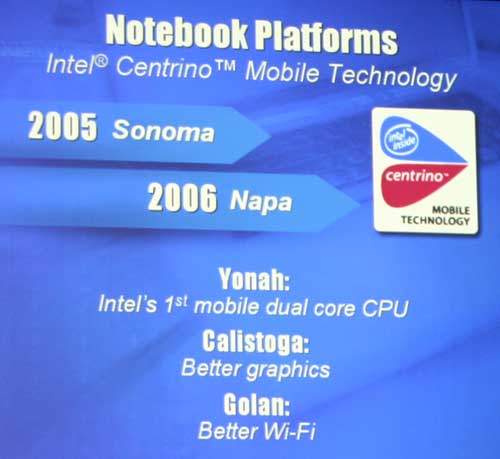
Initially Maloney mentioned one very interesting item which we should be able to get information on later today, it's called Digital Media Boost. According to the keynote, Digital Media Boost offers improved SSE instructions and an improved FPU - two relatively weak areas of the current generation Pentium M.
Yonah will also have Intel's Advanced Thermal Manager offering finer grained thermal management.
The Napa platform, on a silicon basis, will be physically a lot smaller than current generation Centrino platforms (Sonoma).
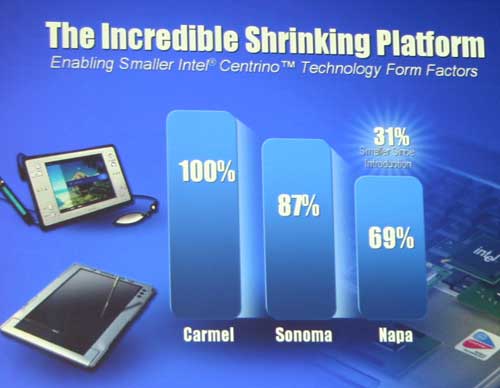
The Golan WiFi solution is significantly smaller thanks to further silicon integration and a move to serial interface.
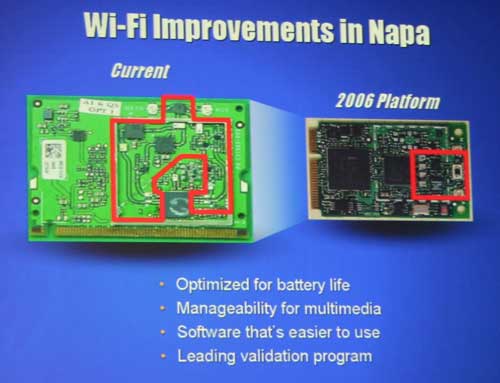
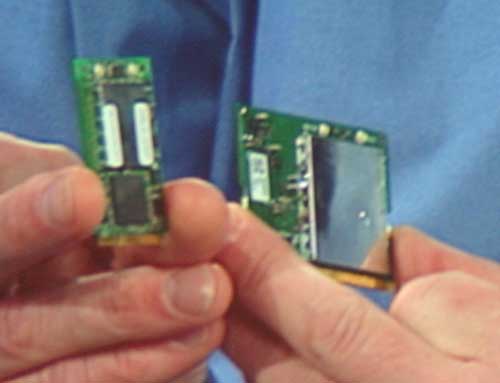
Napa's WiFi is on the left, Sonoma's WiFi is on the right
Yonah vs. Dothan
There was a quick performance bakeoff between a Yonah and a Dothan system, with the test of choice being a multitasking performance comparison - playing a MP3 while transcoding a video.
The first interesting thing we noticed was that MP3 CPU usage for MP3 playback on Dothan was 5 - 10%, while MP3 playback on a Yonah was 0 - 2%.
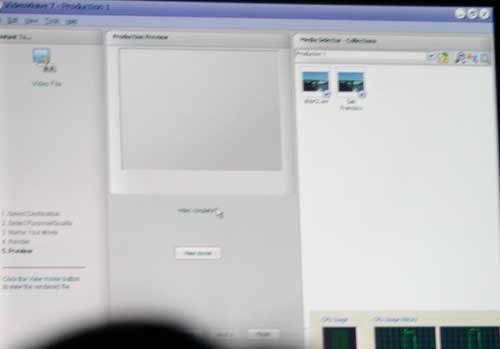
MP3 playback while transcoding a video was significantly faster and had no interruption of the MP3 playback on the Yonah platform, while the Dothan system did drop some audio.
There was not much else shown off but we'll do our best to get the scoop on Yonah today.
TiVo on the Go
Maloney had a TiVo on the Go demonstration, TiVo on the Go is the ability for you to transfer your TiVo recordings to your notebook.
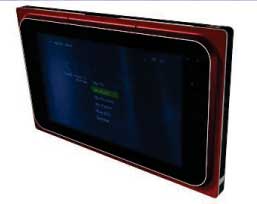
The demo used a prototype On-the-Go media PC based on a Dothan Ultra Low Volt processor. The DVD player on the back of the tablet behind the red cover seen below.
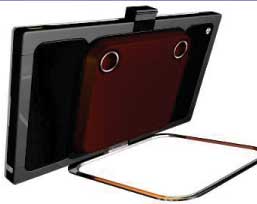
Maloney suggested that with such a small form factor (8.9" wide screen, 2.5 lbs, fanless design) popping one of the tablets into your car to use as a removable entertainment option should be a good option. Or, as an in-car device you'd be able to wirelessly synchronize your movies and recorded content directly to your car.
What's Next?
Maloney's keynote concluded with some more talk about WiFi and WiMAX.
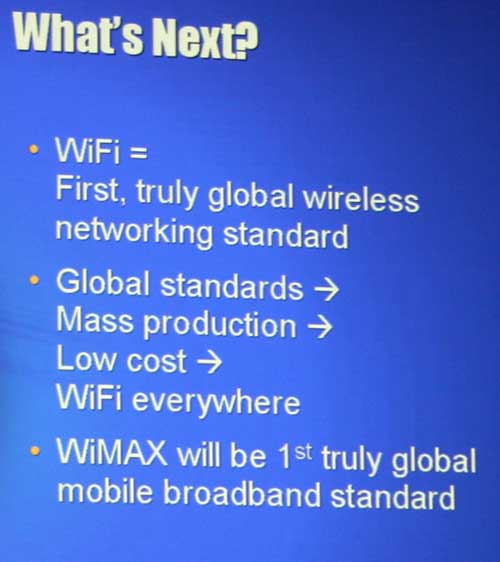
The premise is this: WiFi is the first truly global wireless network standard, which is impressive given the sharp contrast between it and cellular wireless network standards. Imagine how useless WiFi would have been had you not been able to jump on WiFi networks in different countries because of differences in specifications.
Intel wants to make WiMAX the first truly global mobile broadband standard, similar to what has happened with WiFi. Given the history with WiFi, the outlook for WiMAX looks pretty positive.
All network demonstrations during the keynote were done over a WiMAX network.
Final Words
Day 2 has gotten off to a slow start thus far, but we've got tons of meetings and lots of technical tracks to attend, so hopefully we'll have some more interesting tidbits as the day goes on. If you've missed them, here is a recap of our past articles:
IDF Spring 2005 Day 1 - Craig Barrett's Keynote
Updated! IDF Spring 2005 Day 1 - 65nm Multi-Core Demos and more
IDF Spring 2005 - New Pentium D, No More 4
IDF Spring 2005 Day 1 - Gelsinger Speaks, nForce4 Intel and more







